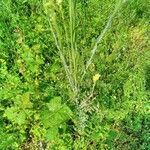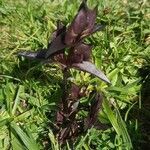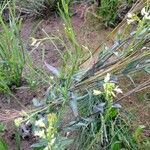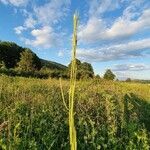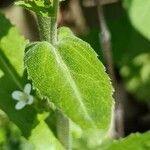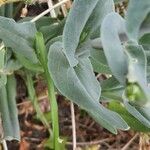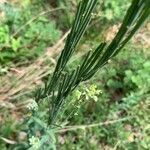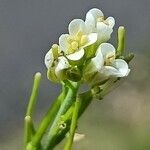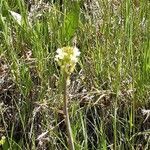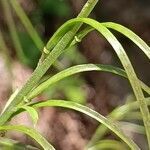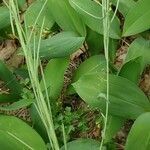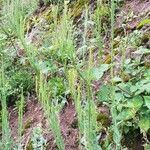Annual to biennial bluish green herb with an evanescent leaf-rosette, from which 1 (rarely more) flowering shoots arise.. Stems unbranched, rigid, erect, 40–150 cm. high, basally somewhat hairy, otherwise glabrous.. Rosette leaves petioled, spathulate to obovate, rather acute, attenuate, entire to sinuate, moderately hairy; blade 2–8 cm. long, 1–2 cm. broad; petiole 0.5–2 cm. long.. Cauline leaves dense, sessile, acutely ovate, amplexicaul to sagittate, entire, glabrous, 2–6 cm. long, ± 1 cm. broad.. Racemes with numerous flowers, in fruit up to 50 cm. long, narrow and dense; pedicels erect, thin, 6–13 mm. long, with erect siliquae.. Sepals yellowish green, oblong, obtuse, 2–4.5 mm. long.. Petals dull white to pale yellow, narrowly spathulate with rounded apex, 4–7 mm. long.. Anthers ± 1.5 mm. long, narrow.. Siliqua linear, 40–70 mm. long, 0.8–1.2 mm. broad; style ± 1 mm. long, with expanded stigma.. Seeds in 2 rows in each locule, reddish brown, flattened, ± semicircular in outline, 0.8–1.2 mm. long, 0.5–0.7 mm. broad, smooth.. Fig. 16.
Erect, densely leafy, generally unbranched biennial herbs up to 1 m or more tall; rarely branched in the upper part. Stem densely retrorsely hairy near the base, glabrous above. Basal leaves in a rosette, often dying off early, oblanceolate, narrowed into a petiole, sharply dentate or repand-dentate, 5-10 cm long, both surfaces scabnd with branched hairs, the midrib of the petiole on both surfaces with a mixture of branched and simple hairs. Stems leaves sessile, sagittate, amplexicual, oblong-lanceolate, acute, entire, glabrous, glaucous, erect and overlapping, the lower ones up to 10 cm long, upwards gradually smaller. Flowers small, the petals 4-6 mm long, oblanceolate. Fruiting raceme elongate up to 60 cm long with 4-12 mm long erect-appressed pedicels. Siliquae 4-8 cm long 1.2-1.8 mm broad, erect, linear, straight; valves 1-nerved, smooth; style very short. Seeds c. 1 mm long, compressed.
Plants (3-)4-12(-15) dm, sparsely to densely pilose basally, glabrous distally, trichomes simple and short-stalked, forked. Basal leaves: blades spatulate, oblanceolate, or oblong, (4-)5-12(-15) cm × 10-30 mm, apex obtuse, surfaces usually pubescent, rarely glabrous. Cauline leaves: blade lanceolate, oblong-elliptic, or ovate, 2-9(-12) cm × (5-)10-25(-40) mm, apex acute. Fruiting pedicels appressed to rachis, (6-)7-16(-20) mm, glabrous. Flowers: sepals (2.5-)3-5 × 0.5-1.2 mm, glabrous; petals 5-8.5 × 1.3-1.7 mm; filaments slender, median pairs 3.5-6.5 mm, lateral pair 2.5-4.5 mm; anthers 0.7-1.5 mm. Fruits (3-)4-10(-12.5) cm × 0.7-1.5 mm; style 0.5-0.8(-1) mm. Seeds 0.6-1.2 × 0.5-0.9 mm. 2n = 12, 16, 32.
Biennial herb, 0.3-1.0 m high, erect, densely leafy, unbranched. Stem retrorsely hairy near base, glabrous above. Leaves: basal leaves rosulate, petiolate, both surfaces scabrid with branched hairs, oblanceolate, margins sharply dentate or repand-dentate; cauline leaves sessile, sagittate, glabrous, glaucous, erect and overlapping, becoming smaller upwards, oblong-lanceolate, margins entire. Inflorescence a raceme. Flowers small. Petals oblanceolate, white, becoming tinged with pink on fading. Fruit a siliqua, erect, linear, straight. Seeds compressed.
Biennial herb 60–120 cm tall, erect, unbranched, glaucous, hairy at base with branched and simple hairs. Basal leaves in a rosette, sinuate-dentate to lyrate, pubescent with stellate hairs, not persistent; cauline leaves ovate to lanceolate, to 28 cm long, saggitate and auriculate, glaucous and glabrous. Sepals spreading, 3.5–5 mm long, the inner pair slightly saccate. Petals 4–6 mm long, pale yellow. Siliqua linear, 30–70 mm long, 1–1.5 mm wide, quadrangular in cross section; pedicels appressed, 7–10 mm long. Seeds ovate, c. 1 mm long.
A cabbage family herb. It takes 2 years to complete its life cycle. It grows 50-120 cm tall. The stems are usually unbranched and the lower parts are hairy. The leaves are in a ring at the base and alternate up the stem. These are 5-15 cm long and 2-3 cm wide. The leaves get smaller up the plant. The leaves on the stems are 2-8 cm long. The flowers are pale yellow. The fruit is a pod that is 4 angled and 4-7 cm long. There are many seeds.
